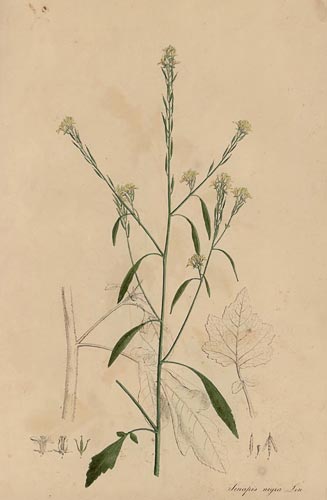Relatives
Brassica nigra (L.) C. Koch - Black mustard, brown mustard.
Taxonomic position.
Family: Brassicaceae; genus: Brassica L.Synonyms.
Sinapis nigra L.Morphology and biology.
Annual plant. Stem is straight, naked or with bristles at the lowermost part. Branches are thin, commonly with anthocyan spots in their axils. Leaves are green, lower ones are downy, middle and upper ones are naked. Lower leaves with lyre-shaped lobes and a large upper part, are set on a stalk. Inflorescence is an incompact raceme. Petals are light yellow; upper part of petal is abruptly tapered into claws, being shorter than the claw. Follicles are tetrahedral, 1-2.5 cm long. Fruit pedicels vary in length from 2.5 to 8.5 mm; on typical plants they are pressed to the stem and clearly torulose. Fruit valves with a distinct midrib and barely visible lateral ribs abruptly terminate in a very thin and short beak. Seed are globular, dark brown, thinly faveolate, about 1.5 mm in diameter. Blossoms from June through September. Entomophilous. 2n=36.Distribution.
General distribution: Central and South-Western Europe, Northern Africa, Central Asia, North and South America (anthropochore), and Northern Australia (anthropochore). As a wild species occurs probably in the Mediterranean countries, and has naturalized in other regions. Within the Former USSR borders occurs in the European part (Lower- and Upper-Volga areas, Crimea) and the Caucasus (Southern Transcaucasus).Ecology.
In secondary disturbed habitats: near homesteads, in orchards and fields, along roads, and river valleys.Utilization and economic value.
Cultivated to prepare mustard powder and essential oil.Reference Citations:
Bush, N.A., ed. 1939. Flora USSR. Cruciferae. Moscow-Leningrad. V. 8: 466-467. (In Russian)Cherepanov S.K. 1995. Plantae Vasculares Rossicae et Civitatum Collimitanearum (in limicis USSR olim). St. Petersburg: Mir I Semia. 990 pp. (In Russian)
Dorofeev V.I. 1998. Family Cruciferae (Brassicaceae) middle Zone of a European part of Russian Federation. Turchaninowia, Barnaul, 1(3): 94. (In Russian)
Dorofeev V.I. 2002. Cruciferae (Brassicaceae) of European Russia. Turchaninowia, Barnaul, 5(3): 115. (In Russian)
Grossgheim A.A. 1950. Flora of Caucasia. Moscow-Leningrad. V.4: 168. (In Russian)
Tsvelev N.N. 2000. Vascular plants of Russia and the contiguous states (Determinant)(Leningrad, Pskov and Novgorod district). St. Petersburg: Publishing House of SPHFA. 781 pp. (In Russian)


